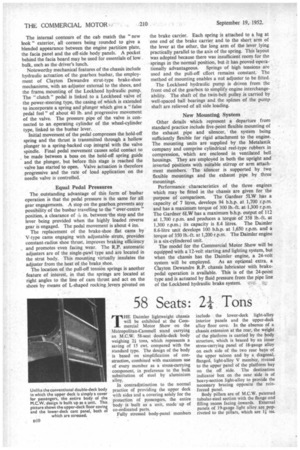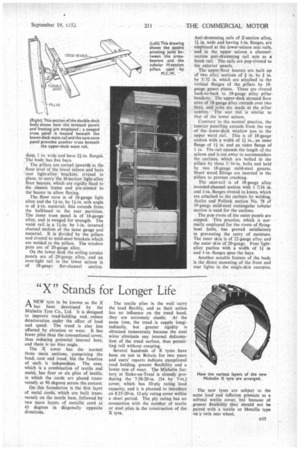58 Seats: 21 Tons
Page 84

Page 87

If you've noticed an error in this article please click here to report it so we can fix it.
THE Daimler lightweight chassis will be exhibited at the Commercial Motor Show on the Metropolitan-Cammell stand carrying an M.C.W. 58-seat double-deck body weighing 2# tons, which represents a saving of 15 cwt. compared with the standard type. The design of the body is based on simplification of construction, combined with maximum use of every member as a stress-carrying component, in preference to the bulk substitution of steel by aluminium alloy.
In contradistinction to the normal practice of providing the upper deck with sides and a covering solely for the protection of passengers, the entire body is built as a unit, made up of co-ordinated parts.
Fully stressed body-panel members
include the lower-deck light-alloy interior panels and the upper-deck alloy floor cove. In the absence of a chassis extension at the rear, the weight of the platform is carried by the body structure, which is braced by an inner stress-carrying panel of 18-gauge alloy on each side of the two rear bays -of the upper saloon and by a diagonal, flanged, light-alloy V member, riveted to the upper panel of the platform bay on the off side. The destination indicator box on the near side is of heavy-section light-alloy to provide the necessary bracing opposite the reinforced panel.
Body pillars are of M.C.W. patented tubular-steel section with the flange and filling recess facing inwards. External panels of 19-gauge light alloy are popriveted to the pillars, which are I ins.
deep, 1 in. wide and have 21-in. flanges-. The body has five bays.
The pillars are curved inwards at the floor level of the lower saloon and have cast light-alloy brackets, riveted in Place, to carry the H-section light-alloy floor bearers, which are rigidly fixed to the chassis frame and pin-jointed to the bearer to allow flexing.
The floor cove is of I8-gauge light alloy and the 14-in. by 14-in. crib angle is of 4-in, material; this extends from the bulkhead to the rear partition. The inner truss panel is of I8-gauge alloy, and is swaged for strength. The waist rail is a 14-in. by 1-in. inverted channel section of the same gauge and material. It is divided by the pillars and riveted to mild-steel brackets which arc welded to the pillars. The window pans are of 20-gauge alloy. On the lower deck the ceiling cornice panels are of 20-gauge alloy, and an over-light rail in the ldwer saloon is of 18-gaup flat-channel section. Anti-drumming rails of Z-section alloy, 14 in. wide and having I-in, flanges, are employed at the lower-saloon seat rails. and in the upper saloon a channelsection anti-drumming rail acts as a finish rail. The rails are pop-riveted to the exterior panels.
The upper-floor bearers are built up of two alloy sections of 4 in. by 4 in. by 3/32 in. which are attached to the vertical flanges of the pillars by 18gauge gusset plates. These are riveted back-to-back to 18-gauge alloy pillar, brackets. The upper-deck stressed floor cove of 18-gauge alloy extends over two bays, and joins are made at the pillar centres. The seat rail is similar to that of the lower saloon.
Contrary to the normal practice, the interior panelling extends from the top of the lower-deck window pan to the upper waist rail. This is of 18-gauge section with a width of I in., an inner flange of 14 in. and an outer flange of 1 in. The rail extends the length of the saloon and is cut away to accommodate the carlines, which are bolted to the pillars by three 5/16-in, bolts and held by two 18-gauge mild-steel gussets. Short wood fillings are inserted in the pillars to prevent crushing.
The cant-rail is of 18-gauge alloy inverted-channel section with 1 7/16 in. and 1-in, flanges riveted to knees, which are attached to the carlines by welding. Accles and Pollock section No. 78 of 19-gauge mild-steel rectangular tubular section is used for the =lines.
The pop rivets of the outer panels are capped. This practice, which is normally employed for the rivets of flyingboat hulls, has proved satisfactory in preventing the entry of moisture. The inner skin is of 22-gauge alloy and the outer skin of 20-gauge. Four lightalloy purlins with a width of 14 in and 1-in, flanges span the bays.
Another notable feature of the body is the direct mounting of the front and rear lights in the single-skin canopies.




































































































































































